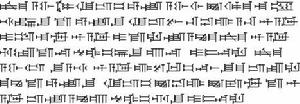
Akkadian cuneiform
Origin:The Akkadian cuneiform script was adapted from Sumerian cuneiform in about 2350 BC. At the same time, many Sumerian words were borrowed into Akkadian, and Sumerian logograms were given both Sumerian and Akkadianreadings. In many ways the process of adapting the Sumerian script to the Akkadian language resembles the way the Chinese script was adapted to write Japanese. Akkadian, like Japanese, was polysyllabicand used a range of inflections while Sumerian, like Chinese, had few or no inflections.The Akkadian script was used until about the 1st century AD and was adapted to write many other languages of Mesopotamia, including Babylonian and Assyrian.
Notable features
Between 200 and 400 symbols were used to Akkadian, though in some texts many more appear.The symbols consisted of phonograms, representing spoken syllables, determinatives, which indicated the category a word belonged to and logograms, which represented whole words.
Many of the symbols had multiple pronunciations.
Used to write:
Akkadian, a Semitic language that was spoken in Mesopotamia (modern Iraq and Syria) between about 2800 BC and 500 AD.
